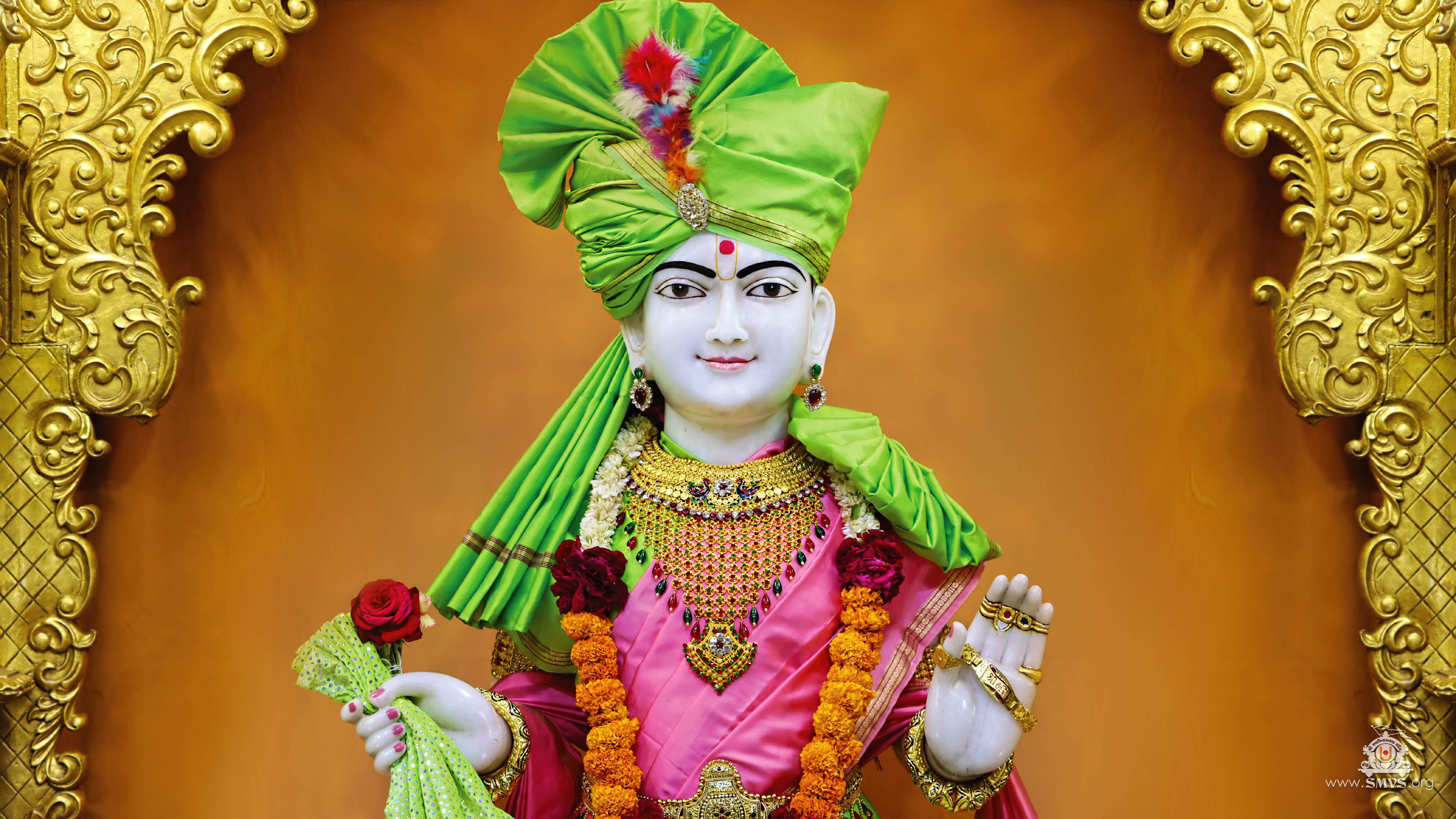
Spiritual Practices
The Spiritual Significance and Legacy of Ārti
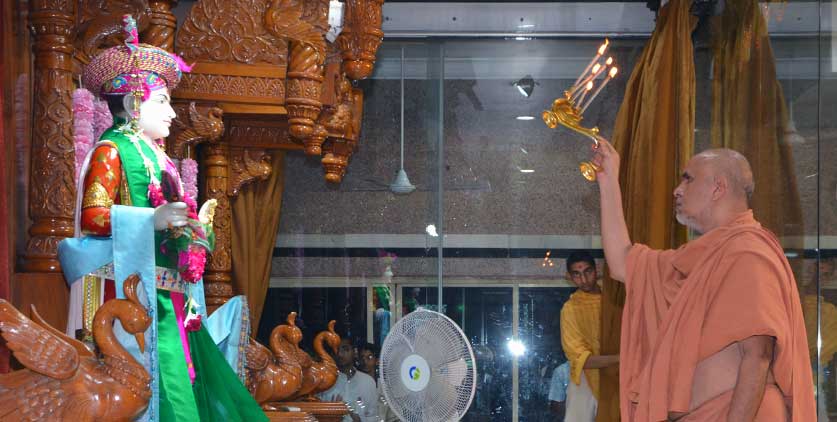
Origins of Ārti – A Legend of Devotion in Darkness
A well-known legend about the origin of Ārti tells of ancient man who lived in a cave—a place of utter darkness. Even amidst such gloom, he maintained deep reverence for Bhagwan. He would enshrine a murti in the cave and offer devotional worship. Yet, the darkness made it impossible to see or serve the Divine properly. So, he would gather dry twigs from the forest, light a fire by rubbing two stones together, set the twigs alight, and with the torchlight, circle it around the murti to behold the Divine form clearly and joyfully.
This ancient act of devotion—lighting up the darkness to see and revere Bhagwan—may be seen as the predecessor of today’s Ārti.
Another account suggests that temple sanctums were typically unlit, and so a lamp was lit to behold the murti. To enable collective darshan, devotees would circle the flame around the murti. Over time, this practice evolved into the ceremonial form of Ārti we recognize today.
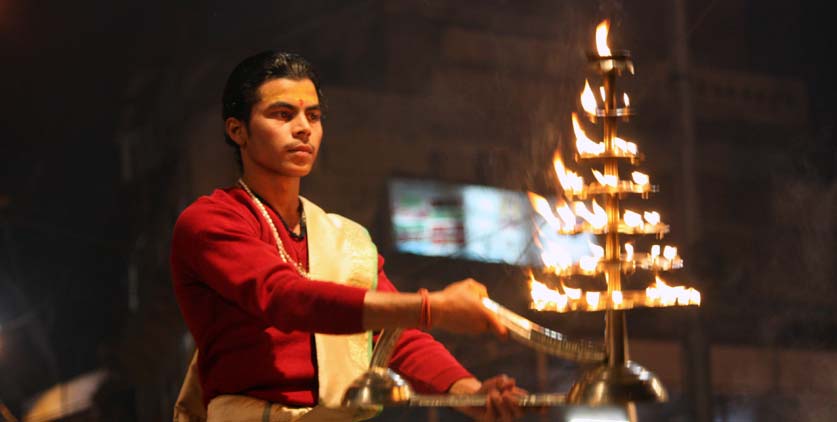
Ārti – An Integral Element of Worship
Wherever there is a murti of Bhagwan, Ārti is inevitable. Whether during consecration, awakening, offering meals, retiring Bhagwan to rest, welcoming Him, or during grand festivals and sabhas—Ārti is ever-present. It is a sacred act of devotion, expressing heartfelt glorification (stuti) and prayer offered with a choked voice, filled with divine emotion.
Ārti is the devotee’s warm and reverent welcome to Bhagwan through light, acknowledging His divine presence. As the flame glows brightly, the devotee prays,
“O Compassionate One, may our lives shine with divine virtues just as this lamp glows with light. Dispel the darkness of māyā and illuminate our hearts with Your eternal relationship.”
As the devotional verse says:
“O Lord! Kindle the flame of life within me.”
He prabhu! jivan jyot jagāvo
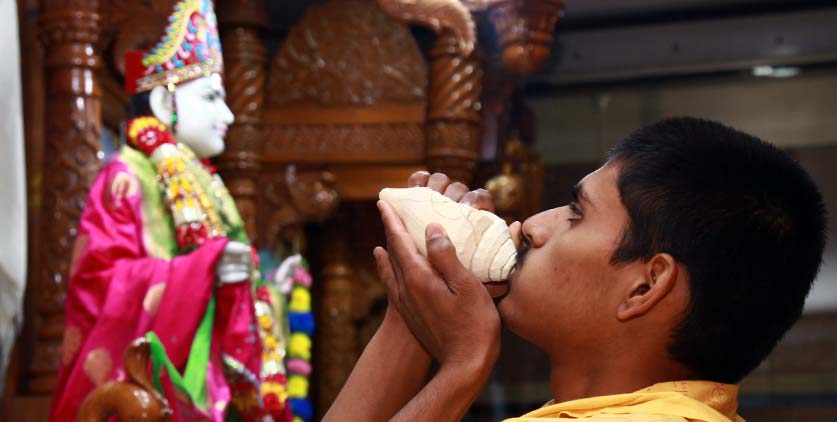
Why Are Bells, Jālars, and Nagāras Played During Ārti?
The ringing of the bell ensures that the devotee remains focused, undistracted by external sounds during heartfelt prayer. The jubilant sounds of the jālar and nagāra symbolize collective joy and spiritual unity among the devotees.
Sound deeply influences the environment and consciousness. Just as rhythmic beats of drums stir the body, the auspicious sounds during Ārti elevate the spiritual atmosphere, enhancing focus on the Divine. The musical celebration affirms the supreme presence of Bhagwan and drowns all distractions, helping devotees become absorbed in His divine form.
Even Bhagwan is immensely pleased upon witnessing the love and devotion of His devotees during Ārti. Indeed, to behold His joy is to receive His divinely blissful gaze. When Bhagwan’s joy is freely offered, why not seize it?
Types of Ārti in the Swaminarayan Sampraday
In Shikharbaddh Mandirs, five Ārtis are performed daily:
1.Mangala Ārti – At dawn, upon Bhagwan’s awakening.
2.Shangār Ārti – After breakfast, adorning Bhagwan with divine attire and ornaments.
3.Rājbhog Ārti – After offering the grand mid-day meal.
4.Sandhyā Ārti – In the evening, post-dinner offering.
5.Shayan Ārti – At night, before retiring Bhagwan to rest.
In Harimandirs and home shrines, generally two Ārtis—morning and evening—are performed.
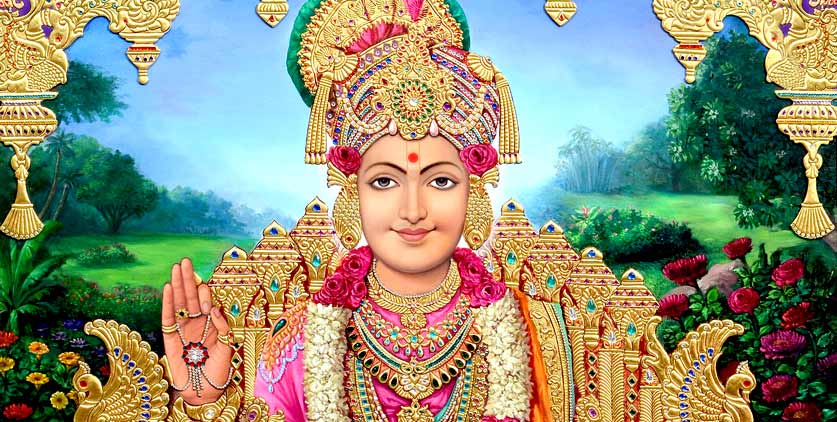
Who Can Perform Ārti?
During the time of Shriji Maharaj, Ārti and other services in Shikharbaddh Mandirs were performed by Brahmacharis. Today, in Shikharbaddh Mandirs, only Sants or Brahmacharis perform Ārti. In Harimandirs, if no Sant is present, devout gruhastha (householder) devotees, after bathing and wearing clean clothes, may perform Ārti. In women’s temples, devout female householders may do so.
The Historical Origins of Ārti in the Sampraday
The first Ārti of Sahajānand Swāmi was performed by Sadguru Rāmānand Swāmi at the time of His enthronement in Jetpur. Though the specific composition sung at that time is not recorded, many Ārti verses were later composed by the Nand Sants in praise of Shriji Maharaj. Notably:
Brahmānand Swāmi composed 8 verses for Mangala, Shangār, and Sandhyā Ārtis.
Muktānand Swāmi composed 5 for Sandhyā Ārti.
Krishnānand Brahmachāri and Premānand Swāmi also contributed verses.
Yet, the most revered and universally sung Ārti in the Sampraday remains:
“Jay Sadguru Swāmi...”(By Sadguru Muktānand Swāmi)
The Divine Revelation of the “Jay Sadguru Swāmi” Ārti
The profound journey behind the composition of the celebrated Ārti "Jai Sadguru Swāmi" reveals the spiritual depths of Sadguru Muktānand Swāmi's transformation. After being entrusted with the leadership of the Sampraday, Sahajānand Swāmi began bestowing samādhi upon countless devotees, both deserving and undeserving, simply through His gaze, voice, or touch. This divine act became widely known and discussed.
However, some senior disciples, deeply loyal to Rāmānand Swāmi, found it difficult to reconcile this phenomenon. Among them were Parvatbhai, Madhavdas, and Muktānand Swāmi himself. Although many began accepting Maharaj’s greatness, Muktānand Swāmi, being the eldest and most respected among them, struggled with doubt.
Hearing growing concerns and complaints, especially during his journey to Kutch to console grieving disciples of Rāmānand Swāmi, Muktānand Swāmi was persuaded to question Maharaj directly. With urgency and resolve, he traveled to Kalvāni village where Shriji Maharaj was staying. Upon arriving, Swāmi sternly expressed his concerns, requesting Maharaj to end the 'extravaganza' of samādhi.
Maharaj, maintaining utmost respect, humbly replied, “Swāmi, even I do not understand how this samādhi occurs. It manifests even with your sankalp."
To illustrate, Maharaj asked Swāmi to make a sankalp, which instantly caused Shāntānand Swāmi to fall into samādhi. This shocked Muktānand Swāmi and planted a seed of reflection.
The next morning, while walking along the Meghvatī River in forest of Khākhrā, Swāmi heard the familiar voice of Rāmānand Swāmi calling him. To his astonishment, he saw his Guru's divine form. Rāmānand Swāmi gently reminded him, “Have you forgotten my words? Sahajānand Swāmi is the Supreme Purushottam Nārāyan. From now on, have no doubt about His actions.”
This divine encounter dissolved all his uncertainties. Filled with joy and reverence, Muktānand Swāmi bathed, gathered fresh forest flowers, and crafted a beautiful garland with love. Entering the assembly where Shriji Maharaj was seated among a congregation of sants and devotees, Swāmi approached with silent grace.
Instead of rebuke, Swāmi offered the garland and picked up the Ārti tray. Overwhelmed with divine emotion, he began to sing from his soul:
“Jai Sadguru Swāmi, Prabhu Jai Sadguru Swāmi, Sahajānand Dayālu, Balavant Bahunāmi...”
The entire atmosphere transformed. Saints and devotees watched in awe as the eldest disciple, now fully convinced of Maharaj’s supremacy, performed the first ever "Jai Sadguru Swāmi" Ārti. From that moment, this composition became the Sampraday's primary evening Ārti, echoing daily in temples worldwide.
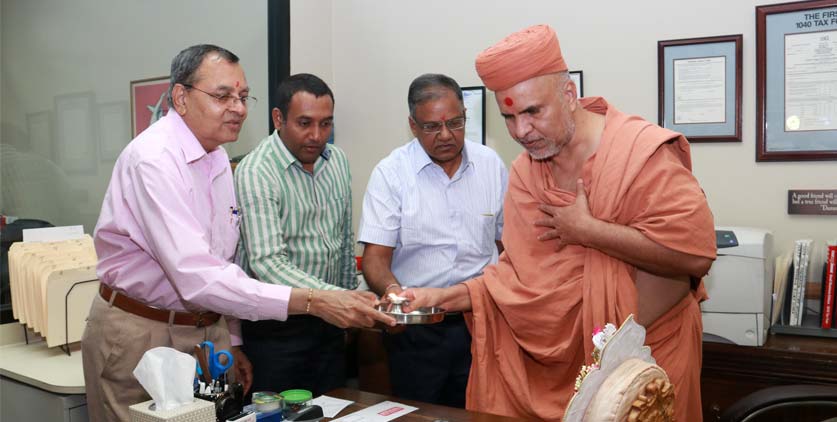
The Meaningful Composition and Interpretation of Ārti
Today, this Ārti is sung daily across the Sampraday. But how deeply do we reflect on the spiritual essence within each line? Have we ever truly contemplated its meanings?
Let us consider how our Gurudev Bapji would reflect on just a single line:
“aḍsaṭh tīrath charaṇe, koṭi gayā kāśī.”
This verse reveals that not just sixty-eight but infinite tīrthas reside at the feet of Shriji Maharaj. The sixty-eight are mentioned simply for emphasis. If infinite holy sites dwell at the feet of our Lord, then by reverently serving or remembering those feet, one can attain similar spiritual merit as visiting renowned tīrthas.
As Jērāma Brahmachāri’s kīrtan affirms:
“tap re tīrathmā huṁ kāīṁ nav jāṇu, sahaje sahaje re huṁ to sukhḍā re māṇu.”
Similarly, Muktānand Swāmi wrote:
“tap-tīrath sādhana svapnameṁ na āve,
jaise koī ghṛta ko chhāṇḍī chhāśa ko na khāve.”
And another verse reminds:
“puruṣottama pragaṭnu je darśana karśe, kāḷa karma thī chhuṭī, kuṭumba sahita
A Divine Practice for Every Household
Every family should make Ārti a non-negotiable daily practice—both morning and evening—at home. This devotional act uplifts, purifies, and sanctifies every soul connected to the home.
Ārti is not just a ritual; it is a daily audience with the Supreme.
It is a direct expression of our bhakti, and the most accessible path to attaining Bhagwan's rajipo.
Mangala Arti
In our organization, the Mangala Arti is recited as follows. It is a vivid description of the auspicious form of God, from toe to crown:
Jaya Mangalkari Prabhu (2), Jaya Ghanshyam Dayalu (2)
Jaya Jaya Sukhkari... Jaya
Mangala Roop Anupam, Nakh-shikh Mangala Chhe (2)
Sukhda Deva Mangala (2), Murti Mangala Chhe... Jaya 01
Mangala Mukhkamal Joi, Sukhma Thijun Chhu (2)
Nasa Nayan Bhrakuti (2), Bhale Rijhun Chhu... Jaya 02
Mangala Hridaykamal Par, Stan Mangala Shobhe (2)
Chhati Upadti Kanthe (2), Munijan Sau Lobhe... Jaya 03
Mangala Hastakamalma, Rekhao Nyari (2)
Kanda Koni Ne Bahu (2), Bal Bharyun Bhari... Jaya 04
Mangala Nabhi Kamal Par, Trivalli Mangala Chhe (2)
Shyam Kati Par Dhoti (2), Udar Mangala Chhe... Jaya 05
Mangala Charan Kamalma, Chihna Bhala Sol (2)
Ghumti Phana Ne Jangha (2), Janu Chhe Gol... Jaya 06
Mangalmay Murtinu, Je Darshan Karse (2)
Dasanudasa Kahe Rasbas (2), Thai Sukhma Tharase... Jaya 07
Shangar Arti
When Maharaj is adorned with garments and ornaments to bless His loving devotees with divine darshan, Shangar Arti is offered. It celebrates the resplendent beauty of His divine form, which captivates the hearts of His devotees.
Rajbhog Arti
At midday, after offering the Maharaj His meal, Rajbhog Arti is performed. This Arti is a divine opportunity to offer gratitude and joy to Maharaj after partaking in the meal.
Sandhya Arti
In the evening, after daily responsibilities are concluded, Sandhya Arti is performed to become God-immersed. The environment during this Arti is peaceful and soothing.
Jay Sadguru Swami, Prabhu Jay Sadguru Swami;
Sahajanand Dayalu(2), Balvant Bahunami... Jay Sadguru (Chorus)
Charne shish dharyathi (2), dukh nakhya todi... Jay Sadguru (1)
Swaminarayan sukhdata, dvijkul tanu dhari (2)
Pamar patit udharya (2), aganit narnaari... Jay Sadguru (2)
Nitya nitya nautam leela, karta avinashi (2)
Adasath tirath charane (2), koti gaya Kashi... Jay Sadguru (3)
Purushottam pragatnu, je darshan karse (2)
Kal karmathi chhuti (2), kutumb sahit tarse... Jay Sadguru (4)
Aa avsar karunanidhi, karuna bahu kidhi (2)
Muktanand kahe mukti (2), sugam kari sidhi... Jay Sadguru (5)
This Arti, composed by Sadguru Muktanand Swami, is sung in many mandirs during evening time. It clearly communicates the divine glory of Shriji Maharaj.
After the Surendranagar Sabha, whenever this Sandhya Arti was sung, Gurudev Bapji would raise one arm with each stanza, moving his hand in rhythm and emphasizing deep, powerful words. His divine joy would visibly radiate from his face during the Arti.
Shayan Arti
At night, Shayan Arti is offered while Maharaj is preparing for His divine bed. In this Arti, we witness a unique bliss on His face. After a day filled with worldly afflictions and distractions, Shayan Arti offers the invaluable chance for inner freedom—it dispels all sorrow.
HDH Swamishri Guidance on Arti:
During Arti, all other activities should be paused.
Close your eyes, fold your hands, and perform Arti—whether in a car, at home, at mandir, in seva, or while traveling.
Arti must be done promptly and with reverence.
Why is water from the conch circled around the Arti flame?
As the Arti is offered from head to toe of the divine form, the flame becomes sanctified and radiant. Circling water from the conch is a formal act of cooling this divine light, though it is not mandatory in all mandirs.
Why take Arti with both hands and place it on the head?
The Arti offered to the Maharaj becomes divine and beyond all attributes (Nirgun). Devotees accept this light upon themselves with both hands, placing it on their heads with the prayer that they too may become divine and Nirgun like the Arti flame.
Why do devotees offer money during Arti?
Since Maharaj allows direct glorification during Arti, and His pleasure is freely available at that moment, devotees offer some form of seva (usually monetary) as an expression of heartfelt gratitude.
True Purpose of Arti
Every family should regularly perform morning and evening Arti at home after understanding its real spiritual purpose. Arti is an integral part of both mandir life and a devotee's daily spiritual routine. When performed with full awareness of Mahaprabhu’s manifest divine glory, the joy of Arti is truly indescribable.












